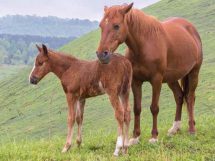AGRIBUSINESS

Traditional rural lending from farm credit associations in recent years has found a growing market niche in rural residential loans. That has equated to specialized financing for land loans, rural home loans, lot loans, and recreational land loans seeding private spaces for hunting, fishing and horseback riding.
This is evidenced by the growth of Rural 1st, a booming business segment of Louisville-based Farm Credit Mid-America, and other rural lenders. And it’s part of extending the mission of farm credit associations, which have partnered together to improve rural America and lifestyles, since the Farm Credit Act of 1971.
Kentucky has been the seed for this specialized rural residential loan growth, in part because Farm Credit Mid-America is based here. Farm Credit Mid-America is an agricultural lending cooperative owned and controlled by their customers and is one of the largest associations within the Farm Credit System, a nationwide network of borrower-owned lending institutions and specialized service organizations. With more than 1,100 employees, Farm Credit Mid-America serves nearly 90,000 customers throughout Indiana, Ohio, Kentucky and Tennessee.
Kentucky also has strength in the Farm Credit System with River Valley Ag Credit and Central Kentucky Ag Credit.
Growing loan lending for rural America becomes even more significant as you look at the numbers. Rural areas cover 97% of the nation’s land area but contain 19.3% of the population (about 60 million people), according to the U.S. Census Bureau. And 64.4% of the total U.S. rural population lives east of the Mississippi River.
The picture of this new residential lending surge through farm credit institutions becomes even clearer by reviewing historical data. Media stories about rural America not having the banking support it needed began to surface in the last decade. As reported, rural America went through a period of banking interest decline. In December 2017, The Wall Street Journal reported that of America’s 1,980 rural counties, 625 didn’t have a locally owned community bank (twice as many as 1994), and that at least 35 counties had no bank at all, with about 115 served by just one branch.
- IT’S FREE | Sign up for The Lane Report email business newsletter. Receive breaking Kentucky business news and updates daily. Click here to sign up
Historically, being outside a metro area and trying to buy small acreage with various buildings on the property would have been difficult, creating delays in securing the loan needed. But Farm Credit Mid-America and other farm credit associations saw an opportunity three years ago to stick to its mission and offer more options for those seeking what has been deemed “country living.”
Chief Credit Officer Kip Ellington of River Valley Ag Credit reports that they have seen an increase in calls in recent months due to an interest in what consumers are calling “a socially distant property.” For those looking at properties over 20 acres with a home and possibly other structures, loans from River Valley Ag Credit and other farm credit associations are often easier to obtain than going through traditional banking lenders.
“You don’t have to be a full-time farmer to work with us. Particularly because interest rates are at record lows, we are running 30% above last year in these types of rural residential loans (for recreational use and country living),” Ellington said.
Land loans are often short-term loans but under the farm credit association approach, an ag-centric loan is more long term, which allows for gradual property improvements and time to build relationships. Land-loan terms have traditionally been two to five years, with a balloon payment after that time. And land loans are typically more difficult to obtain than other secured loans. However, loans with a focus on improving the land and increasing its value as an investment opportunity for the lender have become more desirable.
Many of those operating in traditional housing finance may not be aware of the Farm Credit System, but FCS institutions have been available to serve farmers, cattlemen and other agribusinesses going back to the establishment of the Federal Farm Loan Act in 1916. The FCS was originally set up as a system of 12 borrower-owned district banks to provide long-term loan methods to local Federal Land Bank Associations. Then, they would provide mortgage loans to those in agriculture.
Historically, farmers, cattlemen and others who represent as owners of their local association are required to purchase stock that is tied to the size of their loans.
Farm credit lenders are critical to the rural communities they serve.
“Part of what we do is help people with an education on country living and as a lender we are more comfortable with rural properties than traditional banks are. We are used to properties that may have ag improvements and acreage,” said Central Kentucky Ag Credit CEO Jim Caldwell. Freddie Mac loans found at a traditional bank, for example, usually look for uniformity—a house with 1 acre or less in a subdivision.
“We do see a new demand for rural homes and it is too soon to see how deep the trend is,” Caldwell said. “These trends tend to move in cycles. The past recession took the wind out of rural living but as more homes began being built again out it the country, there’s been a renewed interest.”
Anecdotally, he is aware of conversations tied to the COVID-19 pandemic where millennials on the coasts are assessing whether they should move to the country and leave behind big city living, as their jobs can afford them telecommuting. Baby boomers are more interested, in these times, in getting a small rural tract and for a large garden, some livestock or a log cabin, for example. He said Central Kentucky Ag Credit has also seen the interest in “organics” drive rural tract purchases—everything from raising alpacas to growing mums.
The good news is that rural America has begun to get attention from Congress for broadband access and support for education as well as entrepreneurial activities.
“Government programs and banking have put a focus on rural communities, including building social enterprises for those challenged to find jobs,” said Bobby Clark, co-founder of the new Social Enterprise Alliance–Kentucky and Sustainable Business Ventures.
“We recognize that ‘going rural’ isn’t quite the same as it used to be,” said Art Whaley, chief lending officer at Rural 1st. “You can now have internet access and rural health care and school options.”
Emphasis on lot loans of 10 to 50 acres with a home on the property can now be done quickly. He said Farm Credit Mid-America has done well in Kentucky, Tennessee, Indiana and Ohio with these loan products under Rural 1st and is now supporting expansion of its footprint through other farm credit associations and other bank partners in the U.S. network in 11 states. An expansion of 5% or more year over year is anticipated in the years ahead, including 2020, Whaley said.
“We are seeing the model of the part-time farmer that may be raising cattle and wants the country living house,” Whaley said, adding that rural residential financing also expands into the financing of recreational properties, like areas for hunting and horseback riding.
COVID-19 seems to have had no negative impact on business.
“Business has not slowed down—our bigger months this year were in May and June,” Whaley said.
Rural 1st’s systems were set up for borrowers to go online to complete their loans and with the staff working from home, it’s all gone smoothly. He cited the use of Blend software for their online loan application combined with other software as being a part of their strength. Rural 1st does compete for loans, but also stressed its partnerships with others, including Farm Credit Services of America. More partners are expected.
Rural 1st is now seeing in excess of $100 million in loan production per month. While turn times can be inflated based on volume, most follow a standard closing cycle of 30 to 60 days. In these loans, if construction of a new home goes with a land acreage sale, there may be a need to wait for the house plans and total costs, Whaley said.
The current low interest-rate environment has also boosted interest in country living, with a higher volume of construction going on in states like Kentucky than in previous years.
One hot spot is western Kentucky, where Rural 1st works with Whitetail Properties. Whitetail was created to bring together buyers and sellers of hunting, ranch and farm land. It now operates in 20 states to date.
“When it comes to rural land use, there haven’t been necessarily the right loan tools to cater to that,” said Alex Gyllstrom, marketing director for Whitetail Properties. “It’s been nice to see that a lending institution (through Rural 1st) can acquire that type of property. With the pandemic, there has been a great influx of buyer activity. We have noticed that people have re-prioritized and have brought rural residential land use to the forefront. We see that land has been a safe long-term investment—the value has only grown and accrued more value. People are looking at getting out of crowded and populated areas and they look to enjoy more fresh air.”
Gyllstrom noted that western Kentucky is agriculturally strong and sound, and Whitetail Properties has definitely seen an increase in interest there, especially for recreational land use. Whitetail currently holds 320 listings in Kentucky, an increase over last year.
“What makes us different as a lender is the mission. Our customers are our owners—it’s part of our core culture,” Whaley pointed out. He’s been with Farm Credit Mid-America for 20 years as a loan officer and expects growth to continue because country living appeals to all ages. And, he has not seen any decrease in values on the residential side, making country living even more attractive.
“The launch of Rural 1st was a conscious decision to build out technology to better serve our customers and serve their mission,” he said. “It’s a return to agriculture–a house plus 50 acres—and people are choosing it as a lifestyle. We facilitate our customer’s dreams coming true.” ■
Dawn Marie Yankeelov is a correspondent for The Lane Report. She can be reached at editorial@lanereport.com.






Add Comment